Inter-Firm Rivalry Analysis in the Airline Industry Report
VerifiedAdded on 2020/05/11
|13
|3091
|146
Report
AI Summary
This report examines the sources of competitive advantage for multinational companies in the airline industry, particularly those based in emerging economies like India and China. It analyzes global market opportunities, including market commonality and resource similarity, and explores how these companies leverage global knowledge, financial strengths, and resource sharing to compete. The report investigates the impact of outsourcing, product lines, and consumer bases on inter-firm rivalry. It also discusses arguments and claims regarding competitive advantages and disadvantages in the airline industry. The report examines the hypothesis of globalization, and provides insights into the strategic approaches of companies in the airline industry to compete globally. The report further covers the implications of inter-firm rivalry on the airline industry, highlighting the aggressive business strategies of multinational companies.
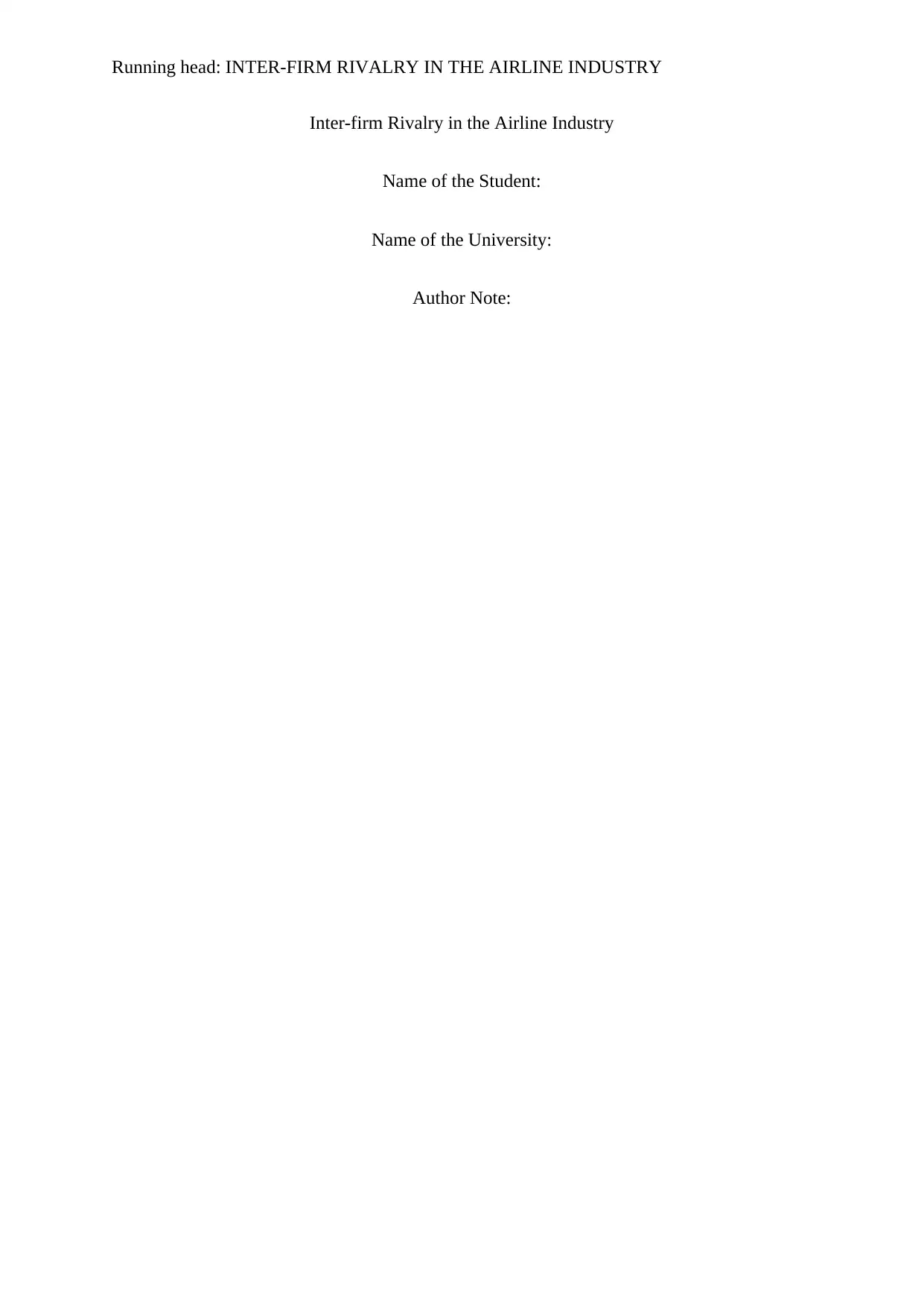
Running head: INTER-FIRM RIVALRY IN THE AIRLINE INDUSTRY
Inter-firm Rivalry in the Airline Industry
Name of the Student:
Name of the University:
Author Note:
Inter-firm Rivalry in the Airline Industry
Name of the Student:
Name of the University:
Author Note:
Paraphrase This Document
Need a fresh take? Get an instant paraphrase of this document with our AI Paraphraser
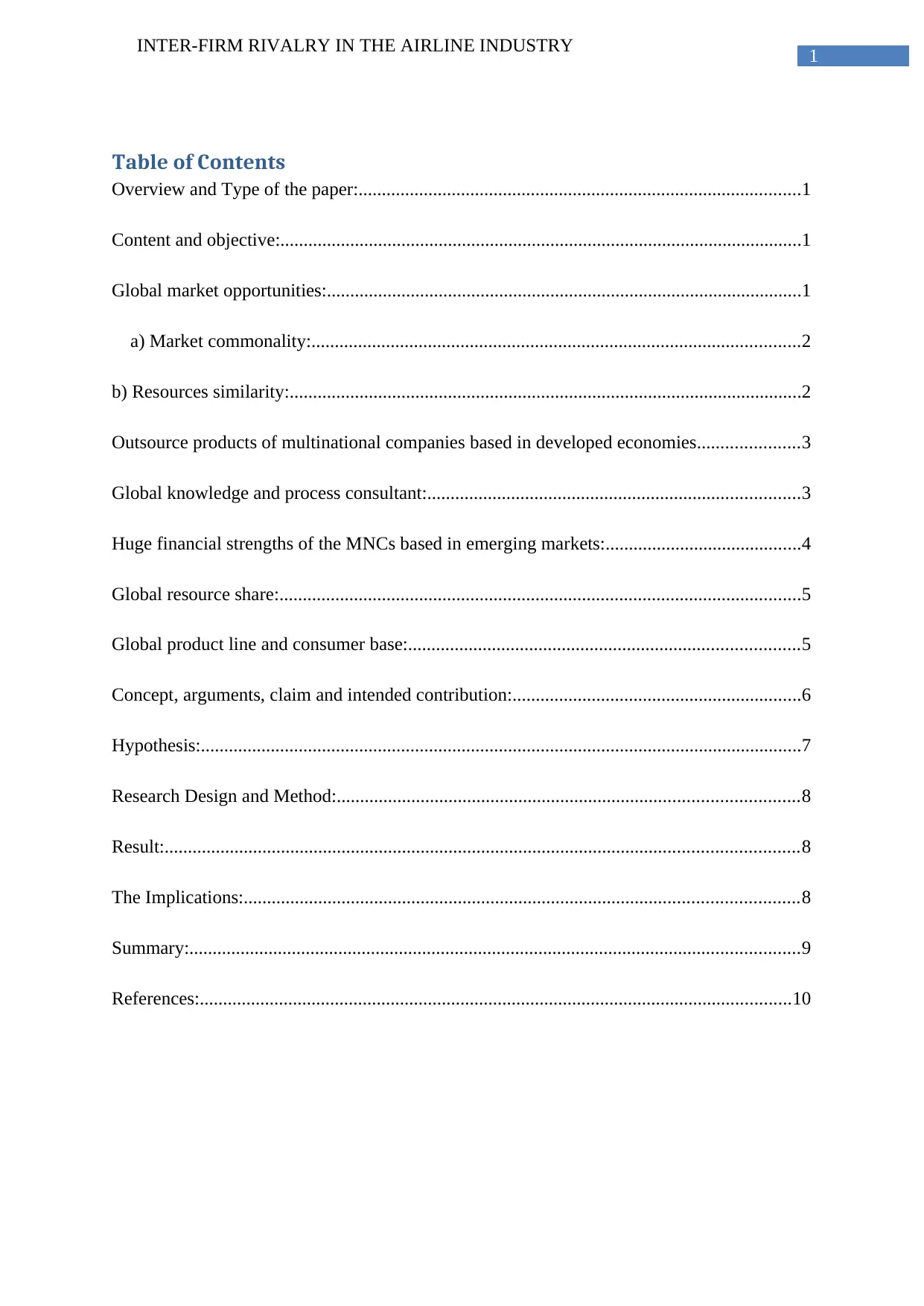
1
INTER-FIRM RIVALRY IN THE AIRLINE INDUSTRY
Table of Contents
Overview and Type of the paper:...............................................................................................1
Content and objective:................................................................................................................1
Global market opportunities:......................................................................................................1
a) Market commonality:.........................................................................................................2
b) Resources similarity:..............................................................................................................2
Outsource products of multinational companies based in developed economies......................3
Global knowledge and process consultant:................................................................................3
Huge financial strengths of the MNCs based in emerging markets:..........................................4
Global resource share:................................................................................................................5
Global product line and consumer base:....................................................................................5
Concept, arguments, claim and intended contribution:..............................................................6
Hypothesis:.................................................................................................................................7
Research Design and Method:...................................................................................................8
Result:........................................................................................................................................8
The Implications:.......................................................................................................................8
Summary:...................................................................................................................................9
References:...............................................................................................................................10
INTER-FIRM RIVALRY IN THE AIRLINE INDUSTRY
Table of Contents
Overview and Type of the paper:...............................................................................................1
Content and objective:................................................................................................................1
Global market opportunities:......................................................................................................1
a) Market commonality:.........................................................................................................2
b) Resources similarity:..............................................................................................................2
Outsource products of multinational companies based in developed economies......................3
Global knowledge and process consultant:................................................................................3
Huge financial strengths of the MNCs based in emerging markets:..........................................4
Global resource share:................................................................................................................5
Global product line and consumer base:....................................................................................5
Concept, arguments, claim and intended contribution:..............................................................6
Hypothesis:.................................................................................................................................7
Research Design and Method:...................................................................................................8
Result:........................................................................................................................................8
The Implications:.......................................................................................................................8
Summary:...................................................................................................................................9
References:...............................................................................................................................10
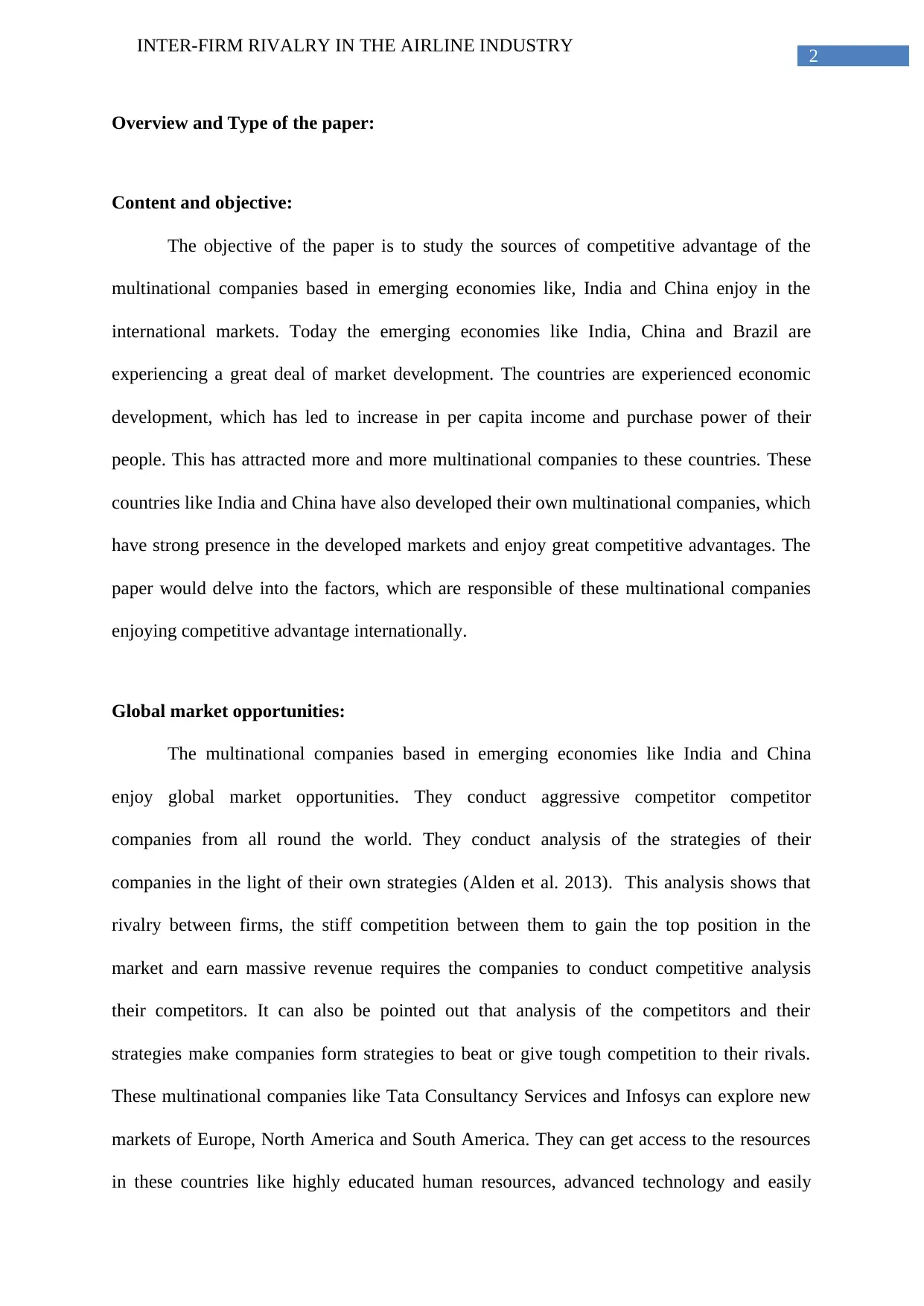
2
INTER-FIRM RIVALRY IN THE AIRLINE INDUSTRY
Overview and Type of the paper:
Content and objective:
The objective of the paper is to study the sources of competitive advantage of the
multinational companies based in emerging economies like, India and China enjoy in the
international markets. Today the emerging economies like India, China and Brazil are
experiencing a great deal of market development. The countries are experienced economic
development, which has led to increase in per capita income and purchase power of their
people. This has attracted more and more multinational companies to these countries. These
countries like India and China have also developed their own multinational companies, which
have strong presence in the developed markets and enjoy great competitive advantages. The
paper would delve into the factors, which are responsible of these multinational companies
enjoying competitive advantage internationally.
Global market opportunities:
The multinational companies based in emerging economies like India and China
enjoy global market opportunities. They conduct aggressive competitor competitor
companies from all round the world. They conduct analysis of the strategies of their
companies in the light of their own strategies (Alden et al. 2013). This analysis shows that
rivalry between firms, the stiff competition between them to gain the top position in the
market and earn massive revenue requires the companies to conduct competitive analysis
their competitors. It can also be pointed out that analysis of the competitors and their
strategies make companies form strategies to beat or give tough competition to their rivals.
These multinational companies like Tata Consultancy Services and Infosys can explore new
markets of Europe, North America and South America. They can get access to the resources
in these countries like highly educated human resources, advanced technology and easily
INTER-FIRM RIVALRY IN THE AIRLINE INDUSTRY
Overview and Type of the paper:
Content and objective:
The objective of the paper is to study the sources of competitive advantage of the
multinational companies based in emerging economies like, India and China enjoy in the
international markets. Today the emerging economies like India, China and Brazil are
experiencing a great deal of market development. The countries are experienced economic
development, which has led to increase in per capita income and purchase power of their
people. This has attracted more and more multinational companies to these countries. These
countries like India and China have also developed their own multinational companies, which
have strong presence in the developed markets and enjoy great competitive advantages. The
paper would delve into the factors, which are responsible of these multinational companies
enjoying competitive advantage internationally.
Global market opportunities:
The multinational companies based in emerging economies like India and China
enjoy global market opportunities. They conduct aggressive competitor competitor
companies from all round the world. They conduct analysis of the strategies of their
companies in the light of their own strategies (Alden et al. 2013). This analysis shows that
rivalry between firms, the stiff competition between them to gain the top position in the
market and earn massive revenue requires the companies to conduct competitive analysis
their competitors. It can also be pointed out that analysis of the competitors and their
strategies make companies form strategies to beat or give tough competition to their rivals.
These multinational companies like Tata Consultancy Services and Infosys can explore new
markets of Europe, North America and South America. They can get access to the resources
in these countries like highly educated human resources, advanced technology and easily
⊘ This is a preview!⊘
Do you want full access?
Subscribe today to unlock all pages.

Trusted by 1+ million students worldwide
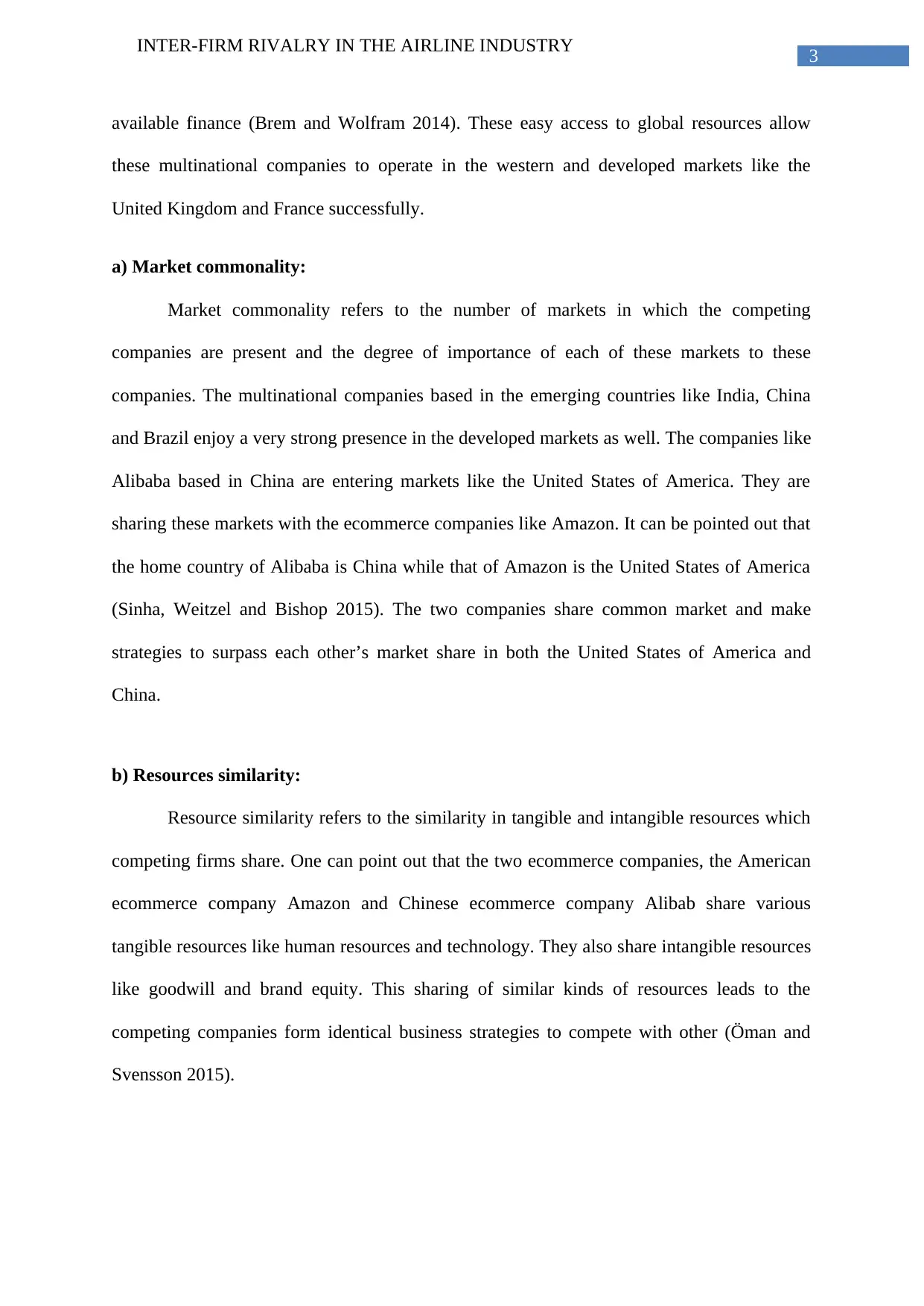
3
INTER-FIRM RIVALRY IN THE AIRLINE INDUSTRY
available finance (Brem and Wolfram 2014). These easy access to global resources allow
these multinational companies to operate in the western and developed markets like the
United Kingdom and France successfully.
a) Market commonality:
Market commonality refers to the number of markets in which the competing
companies are present and the degree of importance of each of these markets to these
companies. The multinational companies based in the emerging countries like India, China
and Brazil enjoy a very strong presence in the developed markets as well. The companies like
Alibaba based in China are entering markets like the United States of America. They are
sharing these markets with the ecommerce companies like Amazon. It can be pointed out that
the home country of Alibaba is China while that of Amazon is the United States of America
(Sinha, Weitzel and Bishop 2015). The two companies share common market and make
strategies to surpass each other’s market share in both the United States of America and
China.
b) Resources similarity:
Resource similarity refers to the similarity in tangible and intangible resources which
competing firms share. One can point out that the two ecommerce companies, the American
ecommerce company Amazon and Chinese ecommerce company Alibab share various
tangible resources like human resources and technology. They also share intangible resources
like goodwill and brand equity. This sharing of similar kinds of resources leads to the
competing companies form identical business strategies to compete with other (Öman and
Svensson 2015).
INTER-FIRM RIVALRY IN THE AIRLINE INDUSTRY
available finance (Brem and Wolfram 2014). These easy access to global resources allow
these multinational companies to operate in the western and developed markets like the
United Kingdom and France successfully.
a) Market commonality:
Market commonality refers to the number of markets in which the competing
companies are present and the degree of importance of each of these markets to these
companies. The multinational companies based in the emerging countries like India, China
and Brazil enjoy a very strong presence in the developed markets as well. The companies like
Alibaba based in China are entering markets like the United States of America. They are
sharing these markets with the ecommerce companies like Amazon. It can be pointed out that
the home country of Alibaba is China while that of Amazon is the United States of America
(Sinha, Weitzel and Bishop 2015). The two companies share common market and make
strategies to surpass each other’s market share in both the United States of America and
China.
b) Resources similarity:
Resource similarity refers to the similarity in tangible and intangible resources which
competing firms share. One can point out that the two ecommerce companies, the American
ecommerce company Amazon and Chinese ecommerce company Alibab share various
tangible resources like human resources and technology. They also share intangible resources
like goodwill and brand equity. This sharing of similar kinds of resources leads to the
competing companies form identical business strategies to compete with other (Öman and
Svensson 2015).
Paraphrase This Document
Need a fresh take? Get an instant paraphrase of this document with our AI Paraphraser
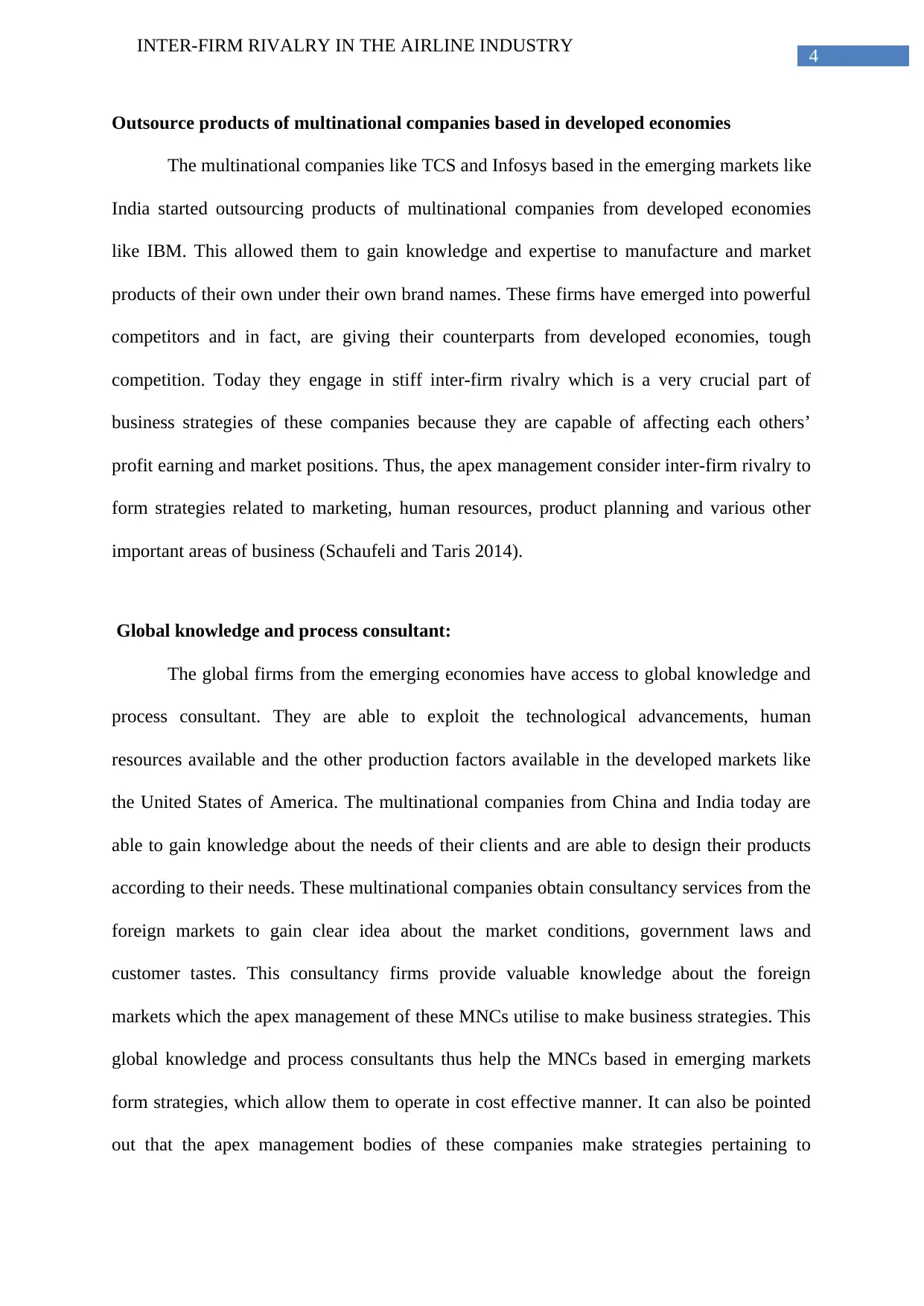
4
INTER-FIRM RIVALRY IN THE AIRLINE INDUSTRY
Outsource products of multinational companies based in developed economies
The multinational companies like TCS and Infosys based in the emerging markets like
India started outsourcing products of multinational companies from developed economies
like IBM. This allowed them to gain knowledge and expertise to manufacture and market
products of their own under their own brand names. These firms have emerged into powerful
competitors and in fact, are giving their counterparts from developed economies, tough
competition. Today they engage in stiff inter-firm rivalry which is a very crucial part of
business strategies of these companies because they are capable of affecting each others’
profit earning and market positions. Thus, the apex management consider inter-firm rivalry to
form strategies related to marketing, human resources, product planning and various other
important areas of business (Schaufeli and Taris 2014).
Global knowledge and process consultant:
The global firms from the emerging economies have access to global knowledge and
process consultant. They are able to exploit the technological advancements, human
resources available and the other production factors available in the developed markets like
the United States of America. The multinational companies from China and India today are
able to gain knowledge about the needs of their clients and are able to design their products
according to their needs. These multinational companies obtain consultancy services from the
foreign markets to gain clear idea about the market conditions, government laws and
customer tastes. This consultancy firms provide valuable knowledge about the foreign
markets which the apex management of these MNCs utilise to make business strategies. This
global knowledge and process consultants thus help the MNCs based in emerging markets
form strategies, which allow them to operate in cost effective manner. It can also be pointed
out that the apex management bodies of these companies make strategies pertaining to
INTER-FIRM RIVALRY IN THE AIRLINE INDUSTRY
Outsource products of multinational companies based in developed economies
The multinational companies like TCS and Infosys based in the emerging markets like
India started outsourcing products of multinational companies from developed economies
like IBM. This allowed them to gain knowledge and expertise to manufacture and market
products of their own under their own brand names. These firms have emerged into powerful
competitors and in fact, are giving their counterparts from developed economies, tough
competition. Today they engage in stiff inter-firm rivalry which is a very crucial part of
business strategies of these companies because they are capable of affecting each others’
profit earning and market positions. Thus, the apex management consider inter-firm rivalry to
form strategies related to marketing, human resources, product planning and various other
important areas of business (Schaufeli and Taris 2014).
Global knowledge and process consultant:
The global firms from the emerging economies have access to global knowledge and
process consultant. They are able to exploit the technological advancements, human
resources available and the other production factors available in the developed markets like
the United States of America. The multinational companies from China and India today are
able to gain knowledge about the needs of their clients and are able to design their products
according to their needs. These multinational companies obtain consultancy services from the
foreign markets to gain clear idea about the market conditions, government laws and
customer tastes. This consultancy firms provide valuable knowledge about the foreign
markets which the apex management of these MNCs utilise to make business strategies. This
global knowledge and process consultants thus help the MNCs based in emerging markets
form strategies, which allow them to operate in cost effective manner. It can also be pointed
out that the apex management bodies of these companies make strategies pertaining to
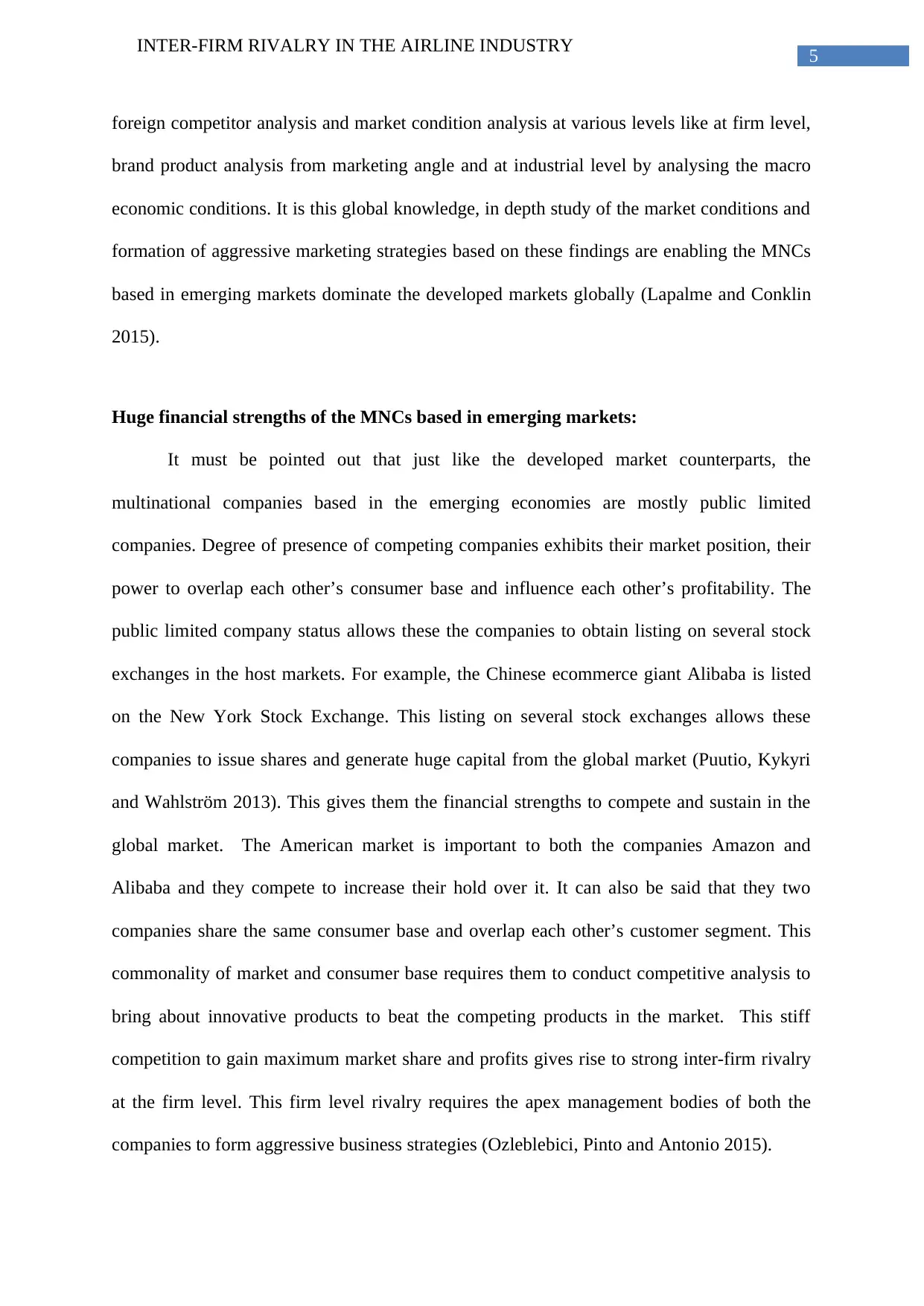
5
INTER-FIRM RIVALRY IN THE AIRLINE INDUSTRY
foreign competitor analysis and market condition analysis at various levels like at firm level,
brand product analysis from marketing angle and at industrial level by analysing the macro
economic conditions. It is this global knowledge, in depth study of the market conditions and
formation of aggressive marketing strategies based on these findings are enabling the MNCs
based in emerging markets dominate the developed markets globally (Lapalme and Conklin
2015).
Huge financial strengths of the MNCs based in emerging markets:
It must be pointed out that just like the developed market counterparts, the
multinational companies based in the emerging economies are mostly public limited
companies. Degree of presence of competing companies exhibits their market position, their
power to overlap each other’s consumer base and influence each other’s profitability. The
public limited company status allows these the companies to obtain listing on several stock
exchanges in the host markets. For example, the Chinese ecommerce giant Alibaba is listed
on the New York Stock Exchange. This listing on several stock exchanges allows these
companies to issue shares and generate huge capital from the global market (Puutio, Kykyri
and Wahlström 2013). This gives them the financial strengths to compete and sustain in the
global market. The American market is important to both the companies Amazon and
Alibaba and they compete to increase their hold over it. It can also be said that they two
companies share the same consumer base and overlap each other’s customer segment. This
commonality of market and consumer base requires them to conduct competitive analysis to
bring about innovative products to beat the competing products in the market. This stiff
competition to gain maximum market share and profits gives rise to strong inter-firm rivalry
at the firm level. This firm level rivalry requires the apex management bodies of both the
companies to form aggressive business strategies (Ozleblebici, Pinto and Antonio 2015).
INTER-FIRM RIVALRY IN THE AIRLINE INDUSTRY
foreign competitor analysis and market condition analysis at various levels like at firm level,
brand product analysis from marketing angle and at industrial level by analysing the macro
economic conditions. It is this global knowledge, in depth study of the market conditions and
formation of aggressive marketing strategies based on these findings are enabling the MNCs
based in emerging markets dominate the developed markets globally (Lapalme and Conklin
2015).
Huge financial strengths of the MNCs based in emerging markets:
It must be pointed out that just like the developed market counterparts, the
multinational companies based in the emerging economies are mostly public limited
companies. Degree of presence of competing companies exhibits their market position, their
power to overlap each other’s consumer base and influence each other’s profitability. The
public limited company status allows these the companies to obtain listing on several stock
exchanges in the host markets. For example, the Chinese ecommerce giant Alibaba is listed
on the New York Stock Exchange. This listing on several stock exchanges allows these
companies to issue shares and generate huge capital from the global market (Puutio, Kykyri
and Wahlström 2013). This gives them the financial strengths to compete and sustain in the
global market. The American market is important to both the companies Amazon and
Alibaba and they compete to increase their hold over it. It can also be said that they two
companies share the same consumer base and overlap each other’s customer segment. This
commonality of market and consumer base requires them to conduct competitive analysis to
bring about innovative products to beat the competing products in the market. This stiff
competition to gain maximum market share and profits gives rise to strong inter-firm rivalry
at the firm level. This firm level rivalry requires the apex management bodies of both the
companies to form aggressive business strategies (Ozleblebici, Pinto and Antonio 2015).
⊘ This is a preview!⊘
Do you want full access?
Subscribe today to unlock all pages.

Trusted by 1+ million students worldwide
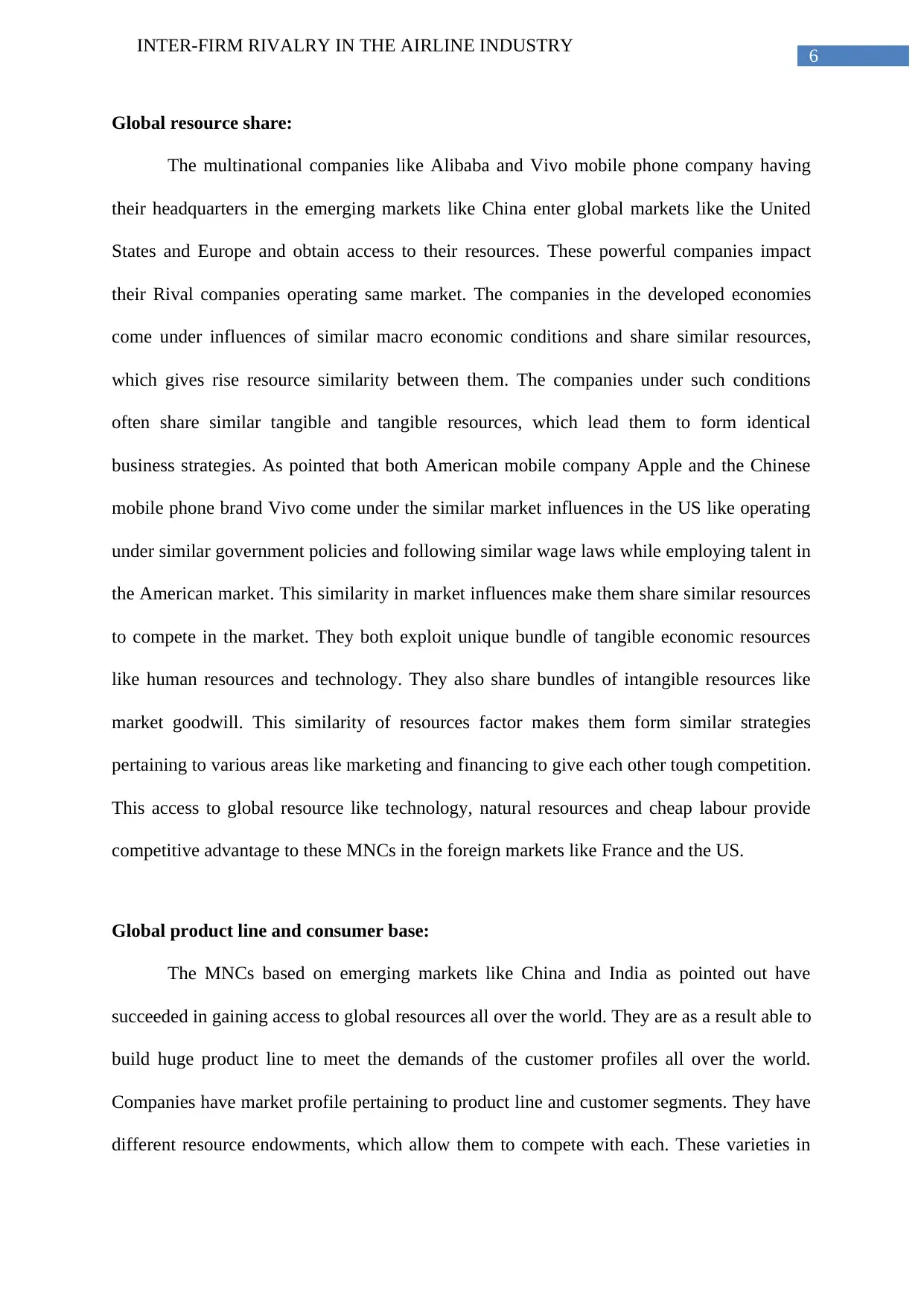
6
INTER-FIRM RIVALRY IN THE AIRLINE INDUSTRY
Global resource share:
The multinational companies like Alibaba and Vivo mobile phone company having
their headquarters in the emerging markets like China enter global markets like the United
States and Europe and obtain access to their resources. These powerful companies impact
their Rival companies operating same market. The companies in the developed economies
come under influences of similar macro economic conditions and share similar resources,
which gives rise resource similarity between them. The companies under such conditions
often share similar tangible and tangible resources, which lead them to form identical
business strategies. As pointed that both American mobile company Apple and the Chinese
mobile phone brand Vivo come under the similar market influences in the US like operating
under similar government policies and following similar wage laws while employing talent in
the American market. This similarity in market influences make them share similar resources
to compete in the market. They both exploit unique bundle of tangible economic resources
like human resources and technology. They also share bundles of intangible resources like
market goodwill. This similarity of resources factor makes them form similar strategies
pertaining to various areas like marketing and financing to give each other tough competition.
This access to global resource like technology, natural resources and cheap labour provide
competitive advantage to these MNCs in the foreign markets like France and the US.
Global product line and consumer base:
The MNCs based on emerging markets like China and India as pointed out have
succeeded in gaining access to global resources all over the world. They are as a result able to
build huge product line to meet the demands of the customer profiles all over the world.
Companies have market profile pertaining to product line and customer segments. They have
different resource endowments, which allow them to compete with each. These varieties in
INTER-FIRM RIVALRY IN THE AIRLINE INDUSTRY
Global resource share:
The multinational companies like Alibaba and Vivo mobile phone company having
their headquarters in the emerging markets like China enter global markets like the United
States and Europe and obtain access to their resources. These powerful companies impact
their Rival companies operating same market. The companies in the developed economies
come under influences of similar macro economic conditions and share similar resources,
which gives rise resource similarity between them. The companies under such conditions
often share similar tangible and tangible resources, which lead them to form identical
business strategies. As pointed that both American mobile company Apple and the Chinese
mobile phone brand Vivo come under the similar market influences in the US like operating
under similar government policies and following similar wage laws while employing talent in
the American market. This similarity in market influences make them share similar resources
to compete in the market. They both exploit unique bundle of tangible economic resources
like human resources and technology. They also share bundles of intangible resources like
market goodwill. This similarity of resources factor makes them form similar strategies
pertaining to various areas like marketing and financing to give each other tough competition.
This access to global resource like technology, natural resources and cheap labour provide
competitive advantage to these MNCs in the foreign markets like France and the US.
Global product line and consumer base:
The MNCs based on emerging markets like China and India as pointed out have
succeeded in gaining access to global resources all over the world. They are as a result able to
build huge product line to meet the demands of the customer profiles all over the world.
Companies have market profile pertaining to product line and customer segments. They have
different resource endowments, which allow them to compete with each. These varieties in
Paraphrase This Document
Need a fresh take? Get an instant paraphrase of this document with our AI Paraphraser
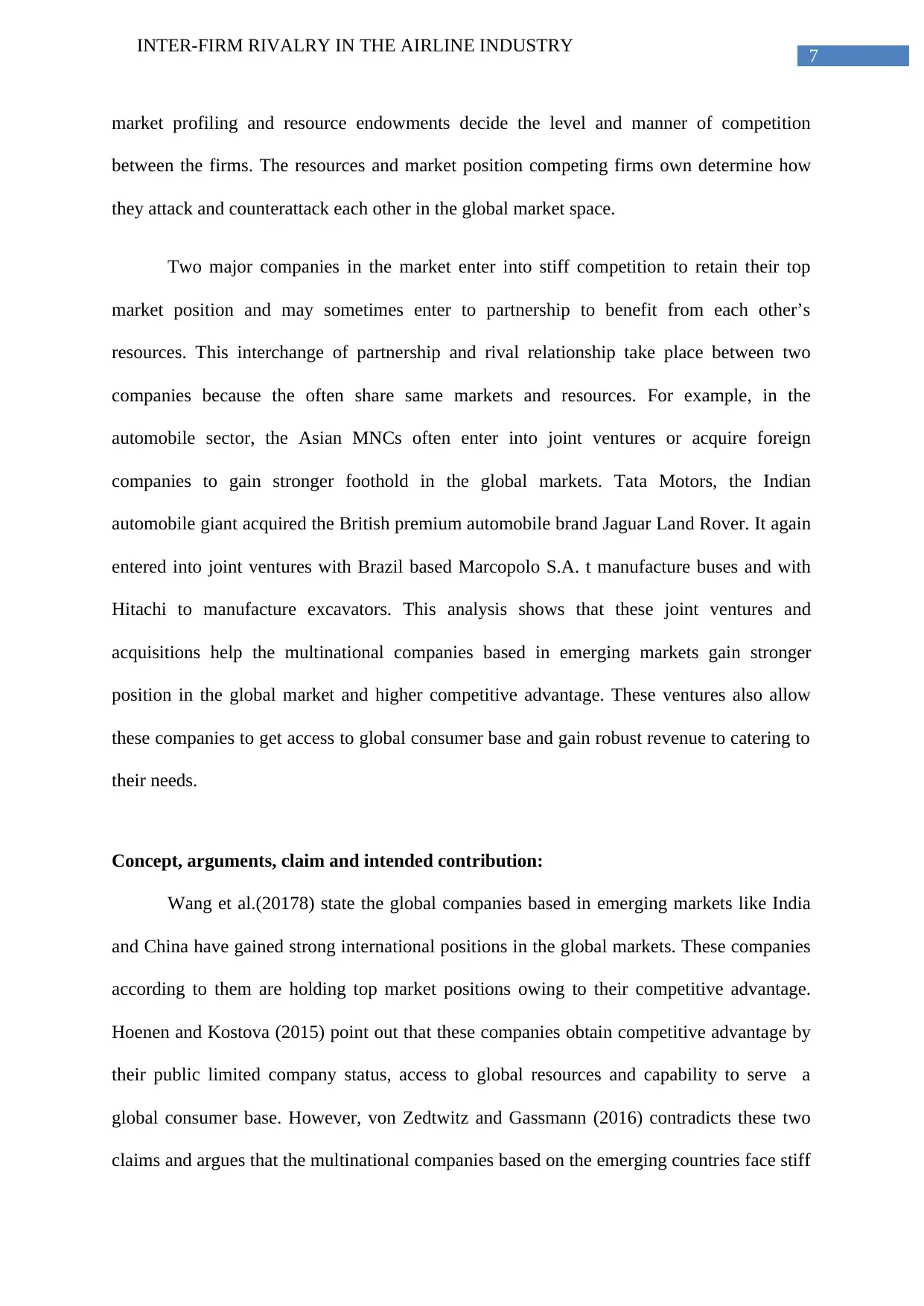
7
INTER-FIRM RIVALRY IN THE AIRLINE INDUSTRY
market profiling and resource endowments decide the level and manner of competition
between the firms. The resources and market position competing firms own determine how
they attack and counterattack each other in the global market space.
Two major companies in the market enter into stiff competition to retain their top
market position and may sometimes enter to partnership to benefit from each other’s
resources. This interchange of partnership and rival relationship take place between two
companies because the often share same markets and resources. For example, in the
automobile sector, the Asian MNCs often enter into joint ventures or acquire foreign
companies to gain stronger foothold in the global markets. Tata Motors, the Indian
automobile giant acquired the British premium automobile brand Jaguar Land Rover. It again
entered into joint ventures with Brazil based Marcopolo S.A. t manufacture buses and with
Hitachi to manufacture excavators. This analysis shows that these joint ventures and
acquisitions help the multinational companies based in emerging markets gain stronger
position in the global market and higher competitive advantage. These ventures also allow
these companies to get access to global consumer base and gain robust revenue to catering to
their needs.
Concept, arguments, claim and intended contribution:
Wang et al.(20178) state the global companies based in emerging markets like India
and China have gained strong international positions in the global markets. These companies
according to them are holding top market positions owing to their competitive advantage.
Hoenen and Kostova (2015) point out that these companies obtain competitive advantage by
their public limited company status, access to global resources and capability to serve a
global consumer base. However, von Zedtwitz and Gassmann (2016) contradicts these two
claims and argues that the multinational companies based on the emerging countries face stiff
INTER-FIRM RIVALRY IN THE AIRLINE INDUSTRY
market profiling and resource endowments decide the level and manner of competition
between the firms. The resources and market position competing firms own determine how
they attack and counterattack each other in the global market space.
Two major companies in the market enter into stiff competition to retain their top
market position and may sometimes enter to partnership to benefit from each other’s
resources. This interchange of partnership and rival relationship take place between two
companies because the often share same markets and resources. For example, in the
automobile sector, the Asian MNCs often enter into joint ventures or acquire foreign
companies to gain stronger foothold in the global markets. Tata Motors, the Indian
automobile giant acquired the British premium automobile brand Jaguar Land Rover. It again
entered into joint ventures with Brazil based Marcopolo S.A. t manufacture buses and with
Hitachi to manufacture excavators. This analysis shows that these joint ventures and
acquisitions help the multinational companies based in emerging markets gain stronger
position in the global market and higher competitive advantage. These ventures also allow
these companies to get access to global consumer base and gain robust revenue to catering to
their needs.
Concept, arguments, claim and intended contribution:
Wang et al.(20178) state the global companies based in emerging markets like India
and China have gained strong international positions in the global markets. These companies
according to them are holding top market positions owing to their competitive advantage.
Hoenen and Kostova (2015) point out that these companies obtain competitive advantage by
their public limited company status, access to global resources and capability to serve a
global consumer base. However, von Zedtwitz and Gassmann (2016) contradicts these two
claims and argues that the multinational companies based on the emerging countries face stiff
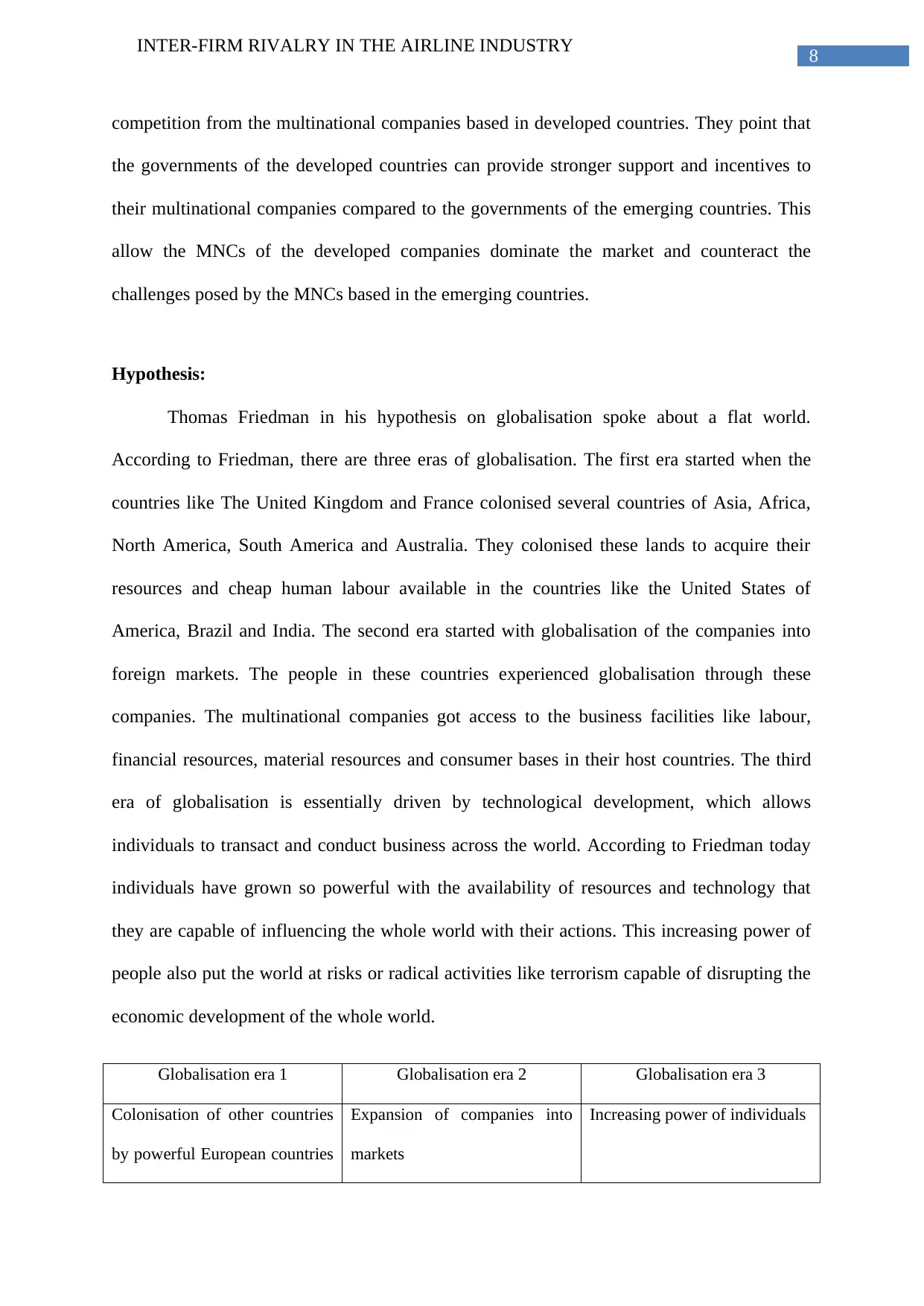
8
INTER-FIRM RIVALRY IN THE AIRLINE INDUSTRY
competition from the multinational companies based in developed countries. They point that
the governments of the developed countries can provide stronger support and incentives to
their multinational companies compared to the governments of the emerging countries. This
allow the MNCs of the developed companies dominate the market and counteract the
challenges posed by the MNCs based in the emerging countries.
Hypothesis:
Thomas Friedman in his hypothesis on globalisation spoke about a flat world.
According to Friedman, there are three eras of globalisation. The first era started when the
countries like The United Kingdom and France colonised several countries of Asia, Africa,
North America, South America and Australia. They colonised these lands to acquire their
resources and cheap human labour available in the countries like the United States of
America, Brazil and India. The second era started with globalisation of the companies into
foreign markets. The people in these countries experienced globalisation through these
companies. The multinational companies got access to the business facilities like labour,
financial resources, material resources and consumer bases in their host countries. The third
era of globalisation is essentially driven by technological development, which allows
individuals to transact and conduct business across the world. According to Friedman today
individuals have grown so powerful with the availability of resources and technology that
they are capable of influencing the whole world with their actions. This increasing power of
people also put the world at risks or radical activities like terrorism capable of disrupting the
economic development of the whole world.
Globalisation era 1 Globalisation era 2 Globalisation era 3
Colonisation of other countries
by powerful European countries
Expansion of companies into
markets
Increasing power of individuals
INTER-FIRM RIVALRY IN THE AIRLINE INDUSTRY
competition from the multinational companies based in developed countries. They point that
the governments of the developed countries can provide stronger support and incentives to
their multinational companies compared to the governments of the emerging countries. This
allow the MNCs of the developed companies dominate the market and counteract the
challenges posed by the MNCs based in the emerging countries.
Hypothesis:
Thomas Friedman in his hypothesis on globalisation spoke about a flat world.
According to Friedman, there are three eras of globalisation. The first era started when the
countries like The United Kingdom and France colonised several countries of Asia, Africa,
North America, South America and Australia. They colonised these lands to acquire their
resources and cheap human labour available in the countries like the United States of
America, Brazil and India. The second era started with globalisation of the companies into
foreign markets. The people in these countries experienced globalisation through these
companies. The multinational companies got access to the business facilities like labour,
financial resources, material resources and consumer bases in their host countries. The third
era of globalisation is essentially driven by technological development, which allows
individuals to transact and conduct business across the world. According to Friedman today
individuals have grown so powerful with the availability of resources and technology that
they are capable of influencing the whole world with their actions. This increasing power of
people also put the world at risks or radical activities like terrorism capable of disrupting the
economic development of the whole world.
Globalisation era 1 Globalisation era 2 Globalisation era 3
Colonisation of other countries
by powerful European countries
Expansion of companies into
markets
Increasing power of individuals
⊘ This is a preview!⊘
Do you want full access?
Subscribe today to unlock all pages.

Trusted by 1+ million students worldwide
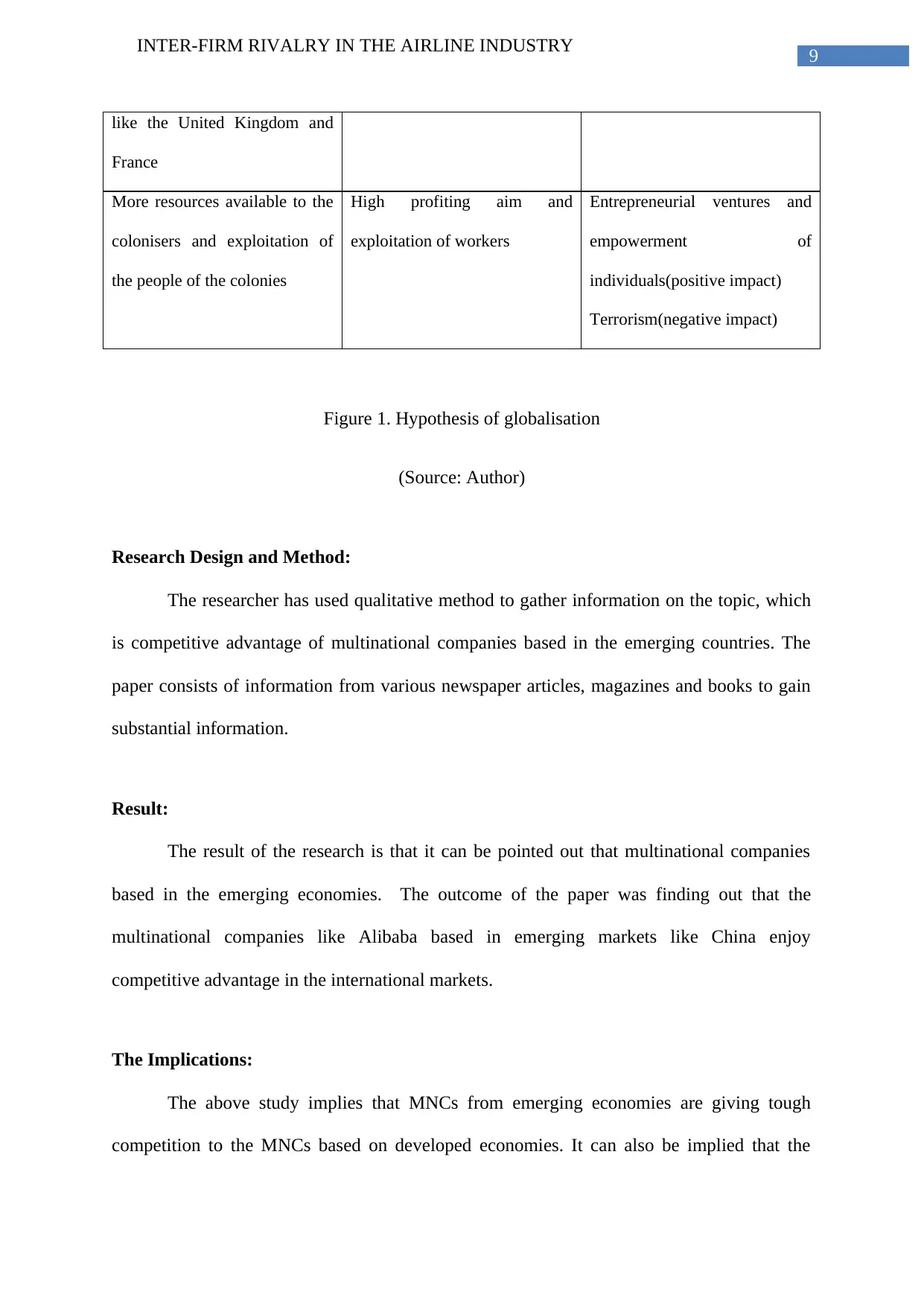
9
INTER-FIRM RIVALRY IN THE AIRLINE INDUSTRY
like the United Kingdom and
France
More resources available to the
colonisers and exploitation of
the people of the colonies
High profiting aim and
exploitation of workers
Entrepreneurial ventures and
empowerment of
individuals(positive impact)
Terrorism(negative impact)
Figure 1. Hypothesis of globalisation
(Source: Author)
Research Design and Method:
The researcher has used qualitative method to gather information on the topic, which
is competitive advantage of multinational companies based in the emerging countries. The
paper consists of information from various newspaper articles, magazines and books to gain
substantial information.
Result:
The result of the research is that it can be pointed out that multinational companies
based in the emerging economies. The outcome of the paper was finding out that the
multinational companies like Alibaba based in emerging markets like China enjoy
competitive advantage in the international markets.
The Implications:
The above study implies that MNCs from emerging economies are giving tough
competition to the MNCs based on developed economies. It can also be implied that the
INTER-FIRM RIVALRY IN THE AIRLINE INDUSTRY
like the United Kingdom and
France
More resources available to the
colonisers and exploitation of
the people of the colonies
High profiting aim and
exploitation of workers
Entrepreneurial ventures and
empowerment of
individuals(positive impact)
Terrorism(negative impact)
Figure 1. Hypothesis of globalisation
(Source: Author)
Research Design and Method:
The researcher has used qualitative method to gather information on the topic, which
is competitive advantage of multinational companies based in the emerging countries. The
paper consists of information from various newspaper articles, magazines and books to gain
substantial information.
Result:
The result of the research is that it can be pointed out that multinational companies
based in the emerging economies. The outcome of the paper was finding out that the
multinational companies like Alibaba based in emerging markets like China enjoy
competitive advantage in the international markets.
The Implications:
The above study implies that MNCs from emerging economies are giving tough
competition to the MNCs based on developed economies. It can also be implied that the
Paraphrase This Document
Need a fresh take? Get an instant paraphrase of this document with our AI Paraphraser
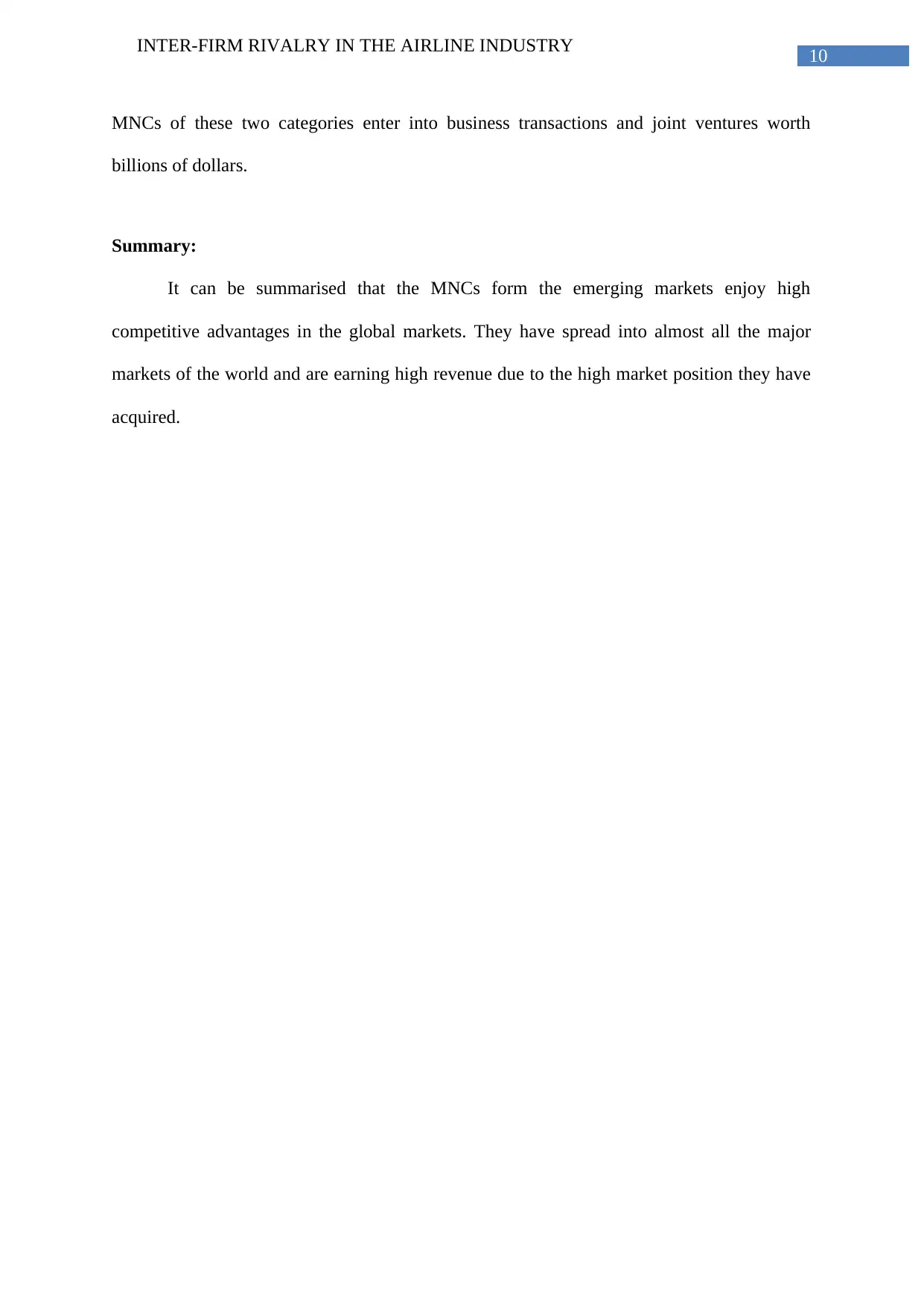
10
INTER-FIRM RIVALRY IN THE AIRLINE INDUSTRY
MNCs of these two categories enter into business transactions and joint ventures worth
billions of dollars.
Summary:
It can be summarised that the MNCs form the emerging markets enjoy high
competitive advantages in the global markets. They have spread into almost all the major
markets of the world and are earning high revenue due to the high market position they have
acquired.
INTER-FIRM RIVALRY IN THE AIRLINE INDUSTRY
MNCs of these two categories enter into business transactions and joint ventures worth
billions of dollars.
Summary:
It can be summarised that the MNCs form the emerging markets enjoy high
competitive advantages in the global markets. They have spread into almost all the major
markets of the world and are earning high revenue due to the high market position they have
acquired.
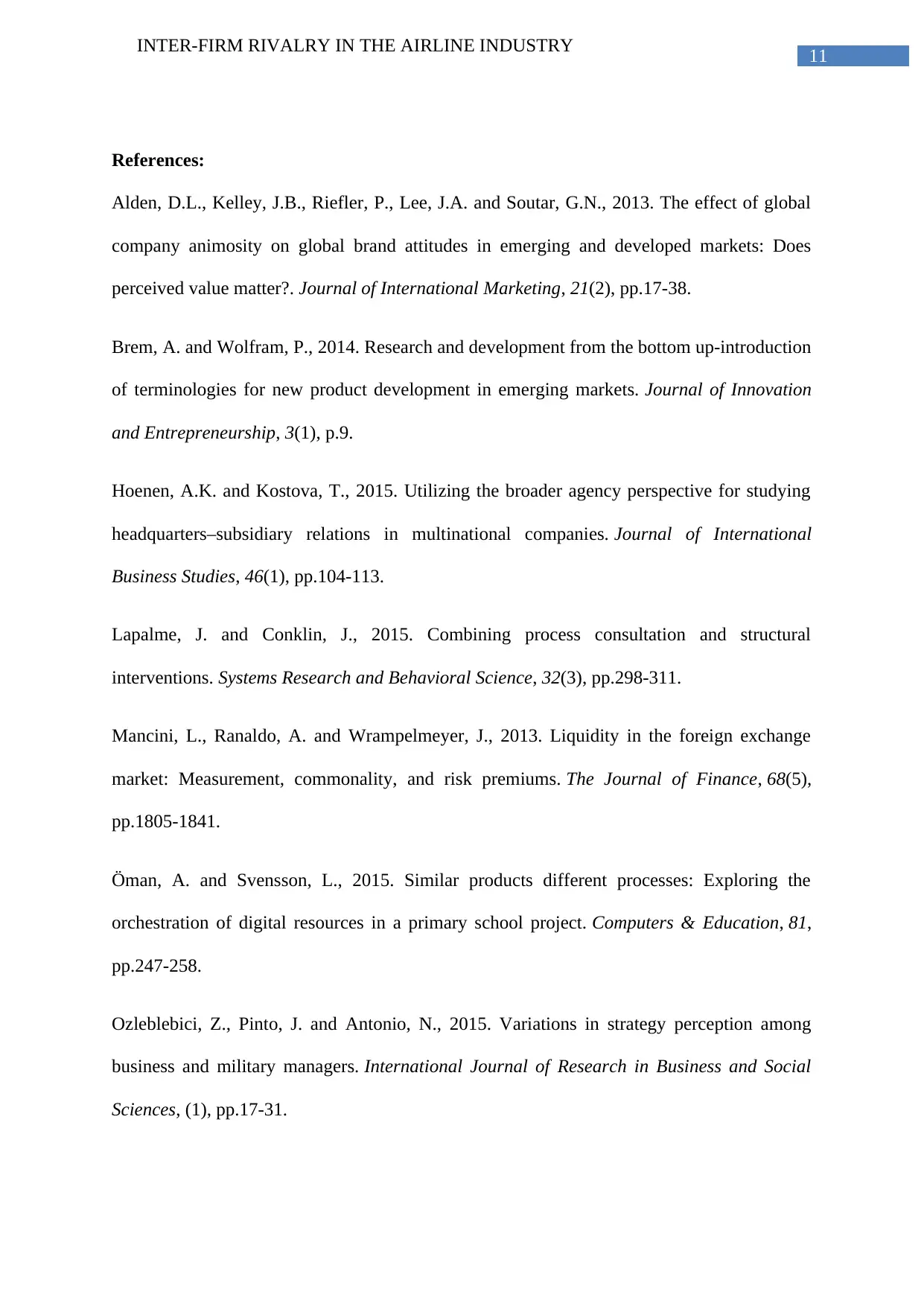
11
INTER-FIRM RIVALRY IN THE AIRLINE INDUSTRY
References:
Alden, D.L., Kelley, J.B., Riefler, P., Lee, J.A. and Soutar, G.N., 2013. The effect of global
company animosity on global brand attitudes in emerging and developed markets: Does
perceived value matter?. Journal of International Marketing, 21(2), pp.17-38.
Brem, A. and Wolfram, P., 2014. Research and development from the bottom up-introduction
of terminologies for new product development in emerging markets. Journal of Innovation
and Entrepreneurship, 3(1), p.9.
Hoenen, A.K. and Kostova, T., 2015. Utilizing the broader agency perspective for studying
headquarters–subsidiary relations in multinational companies. Journal of International
Business Studies, 46(1), pp.104-113.
Lapalme, J. and Conklin, J., 2015. Combining process consultation and structural
interventions. Systems Research and Behavioral Science, 32(3), pp.298-311.
Mancini, L., Ranaldo, A. and Wrampelmeyer, J., 2013. Liquidity in the foreign exchange
market: Measurement, commonality, and risk premiums. The Journal of Finance, 68(5),
pp.1805-1841.
Öman, A. and Svensson, L., 2015. Similar products different processes: Exploring the
orchestration of digital resources in a primary school project. Computers & Education, 81,
pp.247-258.
Ozleblebici, Z., Pinto, J. and Antonio, N., 2015. Variations in strategy perception among
business and military managers. International Journal of Research in Business and Social
Sciences, (1), pp.17-31.
INTER-FIRM RIVALRY IN THE AIRLINE INDUSTRY
References:
Alden, D.L., Kelley, J.B., Riefler, P., Lee, J.A. and Soutar, G.N., 2013. The effect of global
company animosity on global brand attitudes in emerging and developed markets: Does
perceived value matter?. Journal of International Marketing, 21(2), pp.17-38.
Brem, A. and Wolfram, P., 2014. Research and development from the bottom up-introduction
of terminologies for new product development in emerging markets. Journal of Innovation
and Entrepreneurship, 3(1), p.9.
Hoenen, A.K. and Kostova, T., 2015. Utilizing the broader agency perspective for studying
headquarters–subsidiary relations in multinational companies. Journal of International
Business Studies, 46(1), pp.104-113.
Lapalme, J. and Conklin, J., 2015. Combining process consultation and structural
interventions. Systems Research and Behavioral Science, 32(3), pp.298-311.
Mancini, L., Ranaldo, A. and Wrampelmeyer, J., 2013. Liquidity in the foreign exchange
market: Measurement, commonality, and risk premiums. The Journal of Finance, 68(5),
pp.1805-1841.
Öman, A. and Svensson, L., 2015. Similar products different processes: Exploring the
orchestration of digital resources in a primary school project. Computers & Education, 81,
pp.247-258.
Ozleblebici, Z., Pinto, J. and Antonio, N., 2015. Variations in strategy perception among
business and military managers. International Journal of Research in Business and Social
Sciences, (1), pp.17-31.
⊘ This is a preview!⊘
Do you want full access?
Subscribe today to unlock all pages.

Trusted by 1+ million students worldwide
1 out of 13
Related Documents
Your All-in-One AI-Powered Toolkit for Academic Success.
+13062052269
info@desklib.com
Available 24*7 on WhatsApp / Email
![[object Object]](/_next/static/media/star-bottom.7253800d.svg)
Unlock your academic potential
Copyright © 2020–2025 A2Z Services. All Rights Reserved. Developed and managed by ZUCOL.





